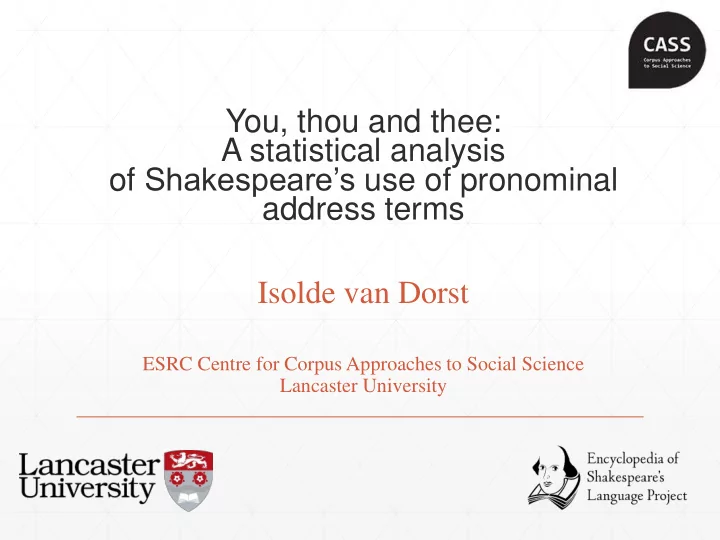

You, thou and thee: A statistical analysis of Shakespeare’s use of pronominal address terms Isolde van Dorst ESRC Centre for Corpus Approaches to Social Science Lancaster University
Background: Early Modern English ▪ Early Modern English (EModE): 1500-1700 ▪ William Shakespeare: 1564-1616 ▪ T/V distinction ▪ Still occurs in other European languages (German du / Sie , French tu / vous , Spanish tú / vos ) ▪ In EModE: ▪ Y OU / THOU ; you / thou / thee
Background: Research on pronoun use ▪ Power and solidarity, gender, age, status, genre, emotion, role of (situational) markedness ▪ “ It is not so much ‘ polite ’ as not ‘ impolite ’; it is not so much ‘ formal ’ as ‘ not informal ’ ” ( Quirk, 1974, p. 50) ▪ It is not a static choice, but a situational marker ▪ One big issue: Use of raw frequency counts ▪ Another issue: Most studies were done on a small dataset ▪ Results so far have been contradictory
Hypotheses ▪ Null-hypothesis: No single model will be able to predict the pronominal address term solely based on linguistic and extra-linguistic features. ▪ Hypothesis 2: The features of social status, age and sentiment will be better prodictors of the pronoun choice than other features. ▪ Hypothesis 3: The best performing algorithm will combine features both dependently and independently.
Encyclopaedia of Shakespeare’s Language http://wp.lancs.ac.uk/shakespearelang/ @ShakespeareLang ▪ AHRC-funded research project at Lancaster University ▪ 38 plays: 36 from the First Folio, plus Two Noble Kinsmen and Pericles: Prince of Tyre ▪ Approx. 1 million words ▪ Richly annotated: Speaker ID, gender, genre, play name, scene ▪ Social status:
Data & Features ▪ 22,932 instances ▪ 14,365 you ; 5,489 thou ; 3,078 thee ▪ 23 linguistic and extra-linguistic features ▪ 10 pre-annotated: Genre, play name, play/act/scene, speaker ID, speaker gender, speaker status, production date, addressee gender, addressee status, no. people addressed ▪ 10 automatic: N-gram (LW1-3, RW1-3), positive sentiment, negative sentiment, addressee ID, status differential ▪ 3 manual: Speaker age, addressee age, location
Data distribution ▪ No. of pronouns extracted from each play range from 363 (in Macbeth ) to 811 (in Coriolanus ) ▪ In Henry VIII , almost no THOU pronouns occur
Methodology ▪ 3 algorithms: Naive Bayes, decision tree, support vector machine ▪ Implemented through Weka ▪ Feature ablation ▪ Evaluated through 10-fold cross-validation ▪ Two types of classification ▪ Trinary classification: you / thou / thee ▪ Binary classification: YOU / THOU ▪ Baseline based on the distribution of the pronouns ▪ 62.6% YOU ; 37.4% THOU
Results: Binary classification
Results: Feature comparison ▪ Most surprising model: Binary decision tree ▪ Most prominent features: N-gram, speaker ID ▪ Features in none of the models: genre, play name, production date, location
Hypotheses ▪ Null-hypothesis: No single model will be able to predict the pronominal address term solely based on linguistic and extra- linguistic features. ▪ Best model (binary support vector machine) scores 24% higher on accuracy than the baseline (with 87%) ▪ Hypothesis 2: The features of social status, age and sentiment will be better prodictors of the pronoun choice than other features. ▪ Partly true as they were indeed good predictors, but the actual best predictors were the N-gram (LW1 and RW1) and speaker ID ▪ Hypothesis 3: The best performing algorithm will combine features both dependently and independently. ▪ On all scores, support vector machine scored best ▪ However, Naive Bayes scored surprisingly well ▪ Depends on preference: simplicity or complexity?
Conclusion ▪ Overall, it is possible to predict the pronoun based on the linguistic and extra-linguistic features ▪ Some features are definitely influencing the pronoun choice more than others ▪ Features are mostly independent of one another ▪ Linguistic context appears to be the key ▪ Some limitations ▪ Familiarity (social distance) ▪ Automatic tagging of the addressee
Thank you for your attention. Any questions?
References Brown, Roger & Gilman, Albert. (1960). “The pronouns of power and solidarity ”, in T.A. Sebeok (ed.), Style in language , pp. 253-276. Cambridge: MIT Press. Busse, Beatrix. (2006). Vocative constructions in the language of Shakespeare [Pragmatics & Beyond 150]. Amsterdam/Philadelphia: John Benjamins. Busse, Ulrich. (2002). The function of linguistic variation in the Shakespeare corpus: A corpus-based study of the morpho-syntactic variability of the address pronouns and their socio-historical and pragmatic implications [Pragmatics & Beyond New Series 106]. Amsterdam/Philadelphia: John Benjamins. Mazzon, Gabriella . (2003). “ Pronouns and nominal address in Shakespearean English: A socio-affective marking system in transition ”, in Irma Taavitsainen and Andreas H. Jucker (eds.), Diachronic perspectives on address term systems [Pragmatics & Beyond New Series 107], pp. 223-249. Amsterdam/Philadelphia: John Benjamins. Stein, Dieter . (2003). “ Pronomial usage in SHakespeare: Beteween sociolinguistics and conversation analysis ”, in Irma Taavitsainen and Andreas H. Jucker (eds.), Diachronic perspectives on address term systems [Pragmatics & Beyond New Series 107], pp. 251-307. Amsterdam/Philadelphia: John Benjamins. Walker, Terry. (2007). Thou and you in Early Modern English dialogues: Trials, depositions, and drama comedy [Pragmatics & Beyond New Series 158]. Amsterdam/Philadelphia: John Benjamins.
Feature examples
Results: Trinary classification
Recommend
More recommend